University Economics Report: Target's Market Analysis in Australia
VerifiedAdded on 2022/11/14
|10
|1961
|69
Report
AI Summary
This report analyzes the retail industry in Australia, focusing on Target, a subsidiary of Wesfarmers. It provides an overview of Target's operations, revenue, and market position, including its 303 physical stores and online services. The report examines the industry background, highlighting the sluggish growth of departmental stores due to e-commerce, and discusses the market structure, which is characterized by perfect competition with numerous sellers and buyers. Key determinants of demand, such as income and personal preferences, and supply, including production costs and technology, are discussed to help managers formulate effective strategies. The report concludes that Target operates in a competitive market and must address demand and supply determinants to maintain its position.

Running head: ECONOMICS
Economics
Name of the Student
Name of the University
Author Note
Economics
Name of the Student
Name of the University
Author Note
Paraphrase This Document
Need a fresh take? Get an instant paraphrase of this document with our AI Paraphraser
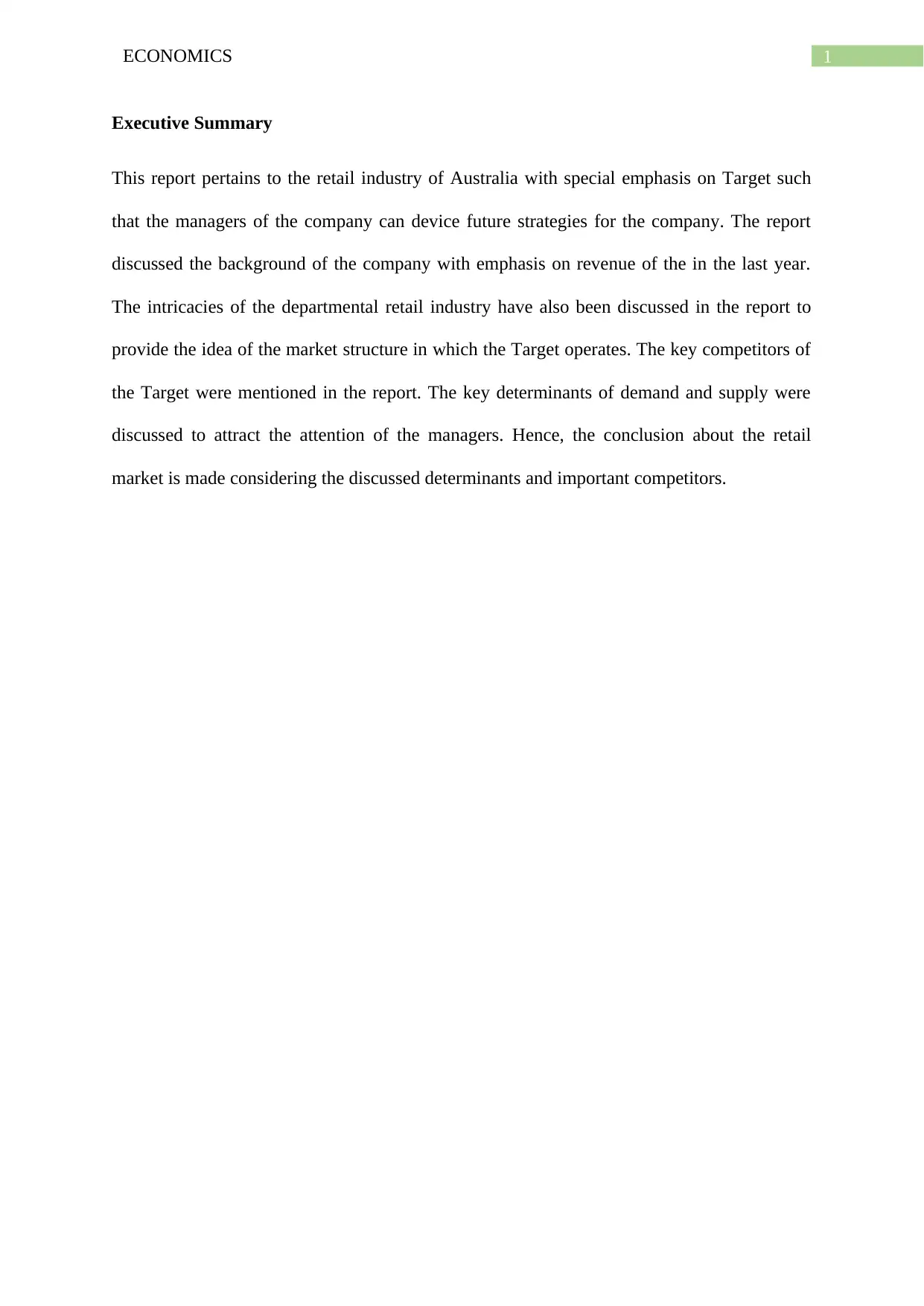
1ECONOMICS
Executive Summary
This report pertains to the retail industry of Australia with special emphasis on Target such
that the managers of the company can device future strategies for the company. The report
discussed the background of the company with emphasis on revenue of the in the last year.
The intricacies of the departmental retail industry have also been discussed in the report to
provide the idea of the market structure in which the Target operates. The key competitors of
the Target were mentioned in the report. The key determinants of demand and supply were
discussed to attract the attention of the managers. Hence, the conclusion about the retail
market is made considering the discussed determinants and important competitors.
Executive Summary
This report pertains to the retail industry of Australia with special emphasis on Target such
that the managers of the company can device future strategies for the company. The report
discussed the background of the company with emphasis on revenue of the in the last year.
The intricacies of the departmental retail industry have also been discussed in the report to
provide the idea of the market structure in which the Target operates. The key competitors of
the Target were mentioned in the report. The key determinants of demand and supply were
discussed to attract the attention of the managers. Hence, the conclusion about the retail
market is made considering the discussed determinants and important competitors.
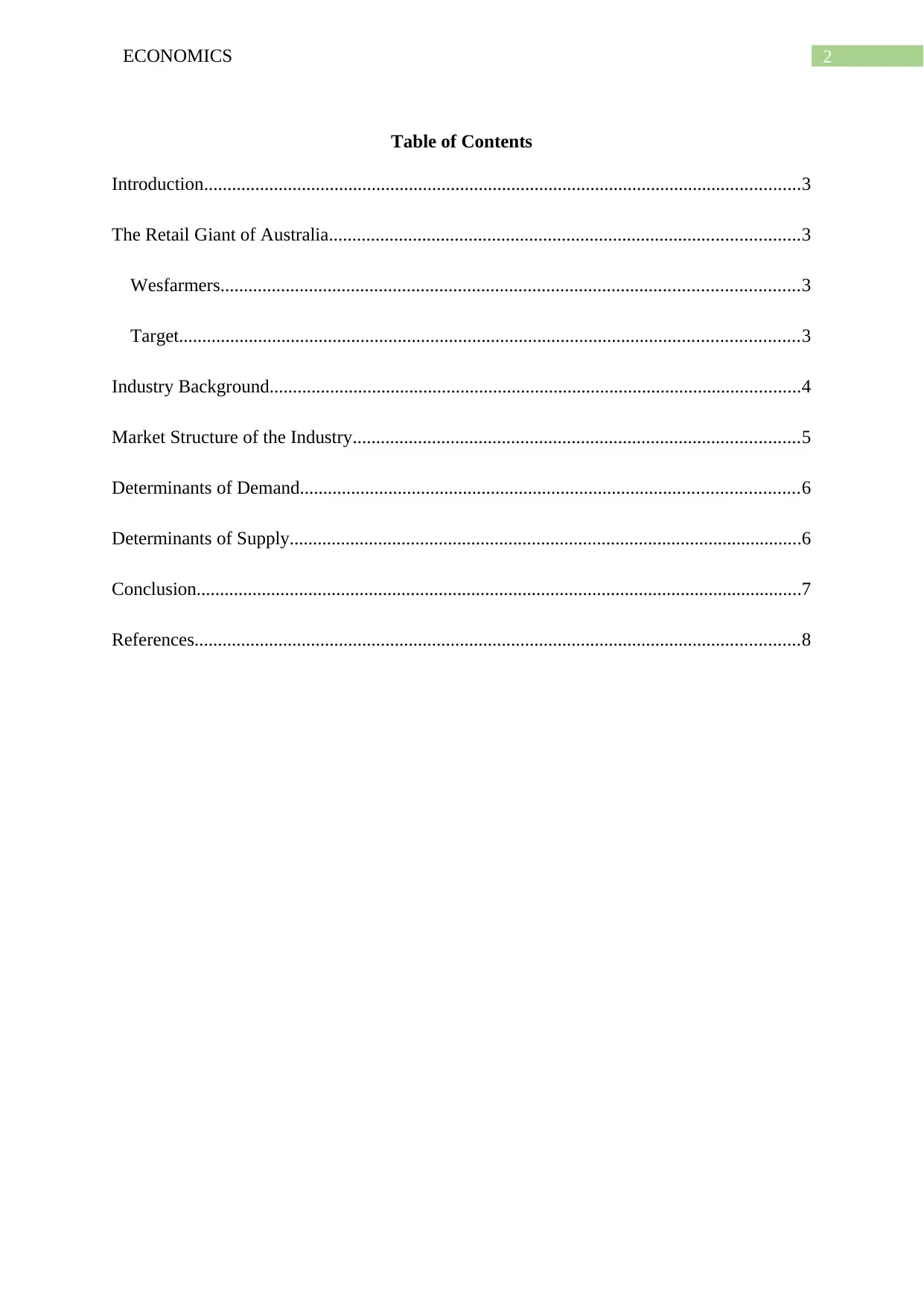
2ECONOMICS
Table of Contents
Introduction................................................................................................................................3
The Retail Giant of Australia.....................................................................................................3
Wesfarmers............................................................................................................................3
Target.....................................................................................................................................3
Industry Background..................................................................................................................4
Market Structure of the Industry................................................................................................5
Determinants of Demand...........................................................................................................6
Determinants of Supply..............................................................................................................6
Conclusion..................................................................................................................................7
References..................................................................................................................................8
Table of Contents
Introduction................................................................................................................................3
The Retail Giant of Australia.....................................................................................................3
Wesfarmers............................................................................................................................3
Target.....................................................................................................................................3
Industry Background..................................................................................................................4
Market Structure of the Industry................................................................................................5
Determinants of Demand...........................................................................................................6
Determinants of Supply..............................................................................................................6
Conclusion..................................................................................................................................7
References..................................................................................................................................8
⊘ This is a preview!⊘
Do you want full access?
Subscribe today to unlock all pages.

Trusted by 1+ million students worldwide
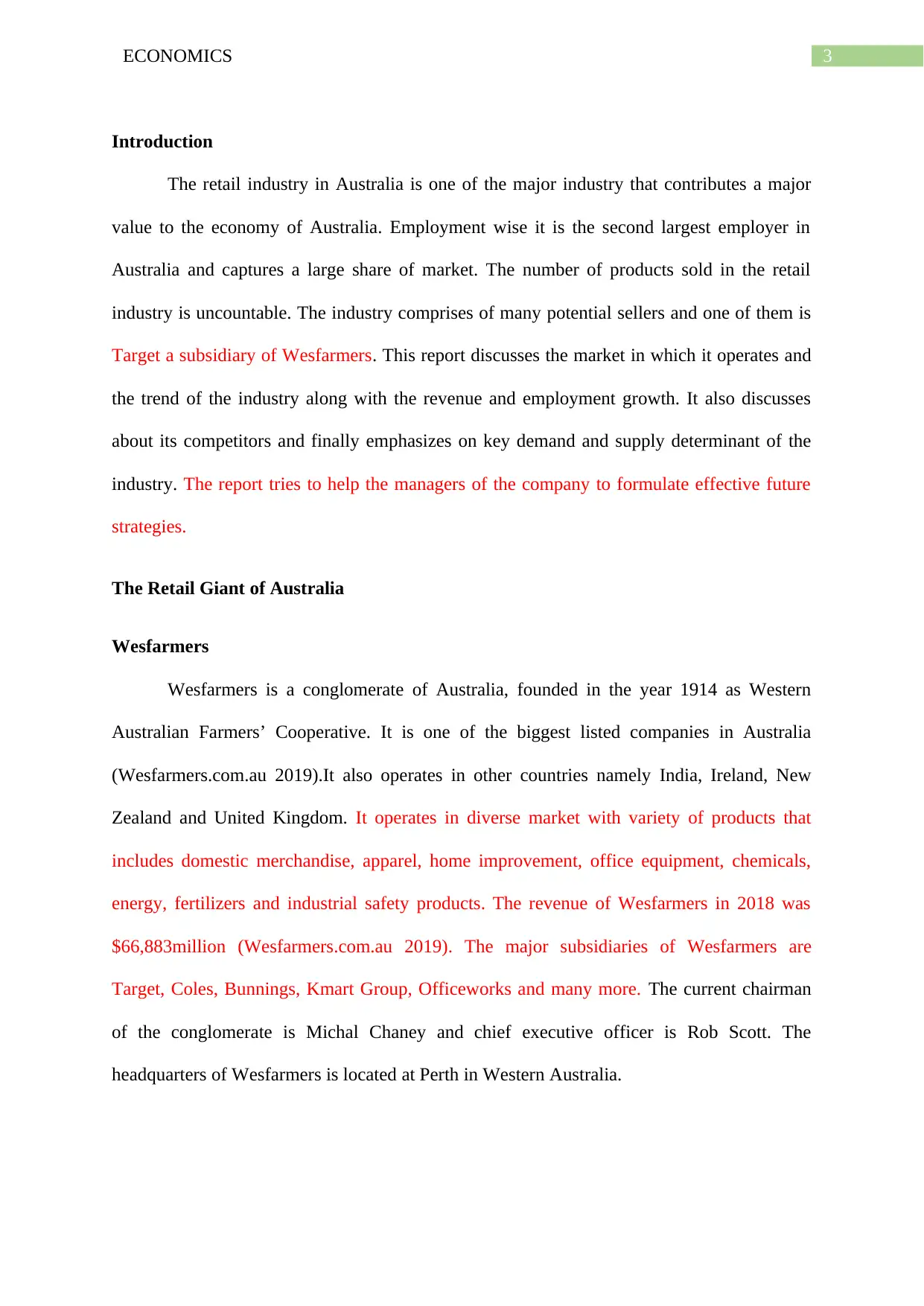
3ECONOMICS
Introduction
The retail industry in Australia is one of the major industry that contributes a major
value to the economy of Australia. Employment wise it is the second largest employer in
Australia and captures a large share of market. The number of products sold in the retail
industry is uncountable. The industry comprises of many potential sellers and one of them is
Target a subsidiary of Wesfarmers. This report discusses the market in which it operates and
the trend of the industry along with the revenue and employment growth. It also discusses
about its competitors and finally emphasizes on key demand and supply determinant of the
industry. The report tries to help the managers of the company to formulate effective future
strategies.
The Retail Giant of Australia
Wesfarmers
Wesfarmers is a conglomerate of Australia, founded in the year 1914 as Western
Australian Farmers’ Cooperative. It is one of the biggest listed companies in Australia
(Wesfarmers.com.au 2019).It also operates in other countries namely India, Ireland, New
Zealand and United Kingdom. It operates in diverse market with variety of products that
includes domestic merchandise, apparel, home improvement, office equipment, chemicals,
energy, fertilizers and industrial safety products. The revenue of Wesfarmers in 2018 was
$66,883million (Wesfarmers.com.au 2019). The major subsidiaries of Wesfarmers are
Target, Coles, Bunnings, Kmart Group, Officeworks and many more. The current chairman
of the conglomerate is Michal Chaney and chief executive officer is Rob Scott. The
headquarters of Wesfarmers is located at Perth in Western Australia.
Introduction
The retail industry in Australia is one of the major industry that contributes a major
value to the economy of Australia. Employment wise it is the second largest employer in
Australia and captures a large share of market. The number of products sold in the retail
industry is uncountable. The industry comprises of many potential sellers and one of them is
Target a subsidiary of Wesfarmers. This report discusses the market in which it operates and
the trend of the industry along with the revenue and employment growth. It also discusses
about its competitors and finally emphasizes on key demand and supply determinant of the
industry. The report tries to help the managers of the company to formulate effective future
strategies.
The Retail Giant of Australia
Wesfarmers
Wesfarmers is a conglomerate of Australia, founded in the year 1914 as Western
Australian Farmers’ Cooperative. It is one of the biggest listed companies in Australia
(Wesfarmers.com.au 2019).It also operates in other countries namely India, Ireland, New
Zealand and United Kingdom. It operates in diverse market with variety of products that
includes domestic merchandise, apparel, home improvement, office equipment, chemicals,
energy, fertilizers and industrial safety products. The revenue of Wesfarmers in 2018 was
$66,883million (Wesfarmers.com.au 2019). The major subsidiaries of Wesfarmers are
Target, Coles, Bunnings, Kmart Group, Officeworks and many more. The current chairman
of the conglomerate is Michal Chaney and chief executive officer is Rob Scott. The
headquarters of Wesfarmers is located at Perth in Western Australia.
Paraphrase This Document
Need a fresh take? Get an instant paraphrase of this document with our AI Paraphraser

4ECONOMICS
Target
Target is one of the largest departmental retail store in Australia primarily deals in
fashion products along with home equipment and cosmetics. It operates both domestically
and internationally. It is operating in this industry since 1926, from one store then it has now
303 physical stores in Australia alone and provides online retail services too. It employs over
13000 employees across all stores, which is around 6% of the total employment provided by
the entire Wesfarmers group. The main objective of Target is to provide quality and trendy
fashion products at reasonable prices.
Industry Background
Target operates in the retail industry in the macro sense. Thus, growth of the retail
Figure 1: Annual revenue of departmental stores
Source: (Statista.com 2019)
Target
Target is one of the largest departmental retail store in Australia primarily deals in
fashion products along with home equipment and cosmetics. It operates both domestically
and internationally. It is operating in this industry since 1926, from one store then it has now
303 physical stores in Australia alone and provides online retail services too. It employs over
13000 employees across all stores, which is around 6% of the total employment provided by
the entire Wesfarmers group. The main objective of Target is to provide quality and trendy
fashion products at reasonable prices.
Industry Background
Target operates in the retail industry in the macro sense. Thus, growth of the retail
Figure 1: Annual revenue of departmental stores
Source: (Statista.com 2019)

5ECONOMICS
industry is directly influenced by the growth of departmental stores. Higher the revenue of
the departmental stores higher will be the growth of retail sector. However, from Figure 1, it
is evident that in the last fifteen years the growth of the departmental stores has been
sluggish. From 2004 to 2008 there was a noticeable growth revenue went up from
$16.43billion to $18.36billion but after that until 2018 remained below $19billion. The
sluggish growth in the departmental stores in Australia is due to the advent of e-commerce
services. Customers nowadays love to buy products from online shopping platforms because
it saves time and price offered by these platforms are very much competitive and in most
cases lower than the stores. Data show that number of departmental stores in Australia is
decreasing. Myer and DJs, the departmental is facing shutdown condition due to heavy losses
in the recent years. Target is also cutting its number of stores by at least 20. Hence, the
departmental store business in Australia is struggling. Departmental stores employs over
82000 people in Australia but the recent revenue growth rate that is -2 percent and future
growth forecast likely to affect the employment adversely (Ibisworld.com.au, 2019). Thus,
the industry is facing several issues in the recent years from competitors from all around.
Market Structure of the Industry
Departmental store sector of the retail industry capture a large share of the domestic
customers of the industry rather it is the largest retail service provider in the domestic product
industry. The sector is characterized by various kind of heterogeneous product from fashion
products to electronics goods. The number of sellers is very high in the sector with numerous
number of brands selling similar kind of products. Thus, the sector is highly competitive.
Therefore, perfect competition prevails in the sector that means there are many sellers and
many buyers (Pindyck and Rubinfeld 2014). With effect of globalization, the number of
competitors has kept on increasing because of entrance of new and big players from foreign
countries. This has increased the competition and price war between the industry players. The
industry is directly influenced by the growth of departmental stores. Higher the revenue of
the departmental stores higher will be the growth of retail sector. However, from Figure 1, it
is evident that in the last fifteen years the growth of the departmental stores has been
sluggish. From 2004 to 2008 there was a noticeable growth revenue went up from
$16.43billion to $18.36billion but after that until 2018 remained below $19billion. The
sluggish growth in the departmental stores in Australia is due to the advent of e-commerce
services. Customers nowadays love to buy products from online shopping platforms because
it saves time and price offered by these platforms are very much competitive and in most
cases lower than the stores. Data show that number of departmental stores in Australia is
decreasing. Myer and DJs, the departmental is facing shutdown condition due to heavy losses
in the recent years. Target is also cutting its number of stores by at least 20. Hence, the
departmental store business in Australia is struggling. Departmental stores employs over
82000 people in Australia but the recent revenue growth rate that is -2 percent and future
growth forecast likely to affect the employment adversely (Ibisworld.com.au, 2019). Thus,
the industry is facing several issues in the recent years from competitors from all around.
Market Structure of the Industry
Departmental store sector of the retail industry capture a large share of the domestic
customers of the industry rather it is the largest retail service provider in the domestic product
industry. The sector is characterized by various kind of heterogeneous product from fashion
products to electronics goods. The number of sellers is very high in the sector with numerous
number of brands selling similar kind of products. Thus, the sector is highly competitive.
Therefore, perfect competition prevails in the sector that means there are many sellers and
many buyers (Pindyck and Rubinfeld 2014). With effect of globalization, the number of
competitors has kept on increasing because of entrance of new and big players from foreign
countries. This has increased the competition and price war between the industry players. The
⊘ This is a preview!⊘
Do you want full access?
Subscribe today to unlock all pages.

Trusted by 1+ million students worldwide
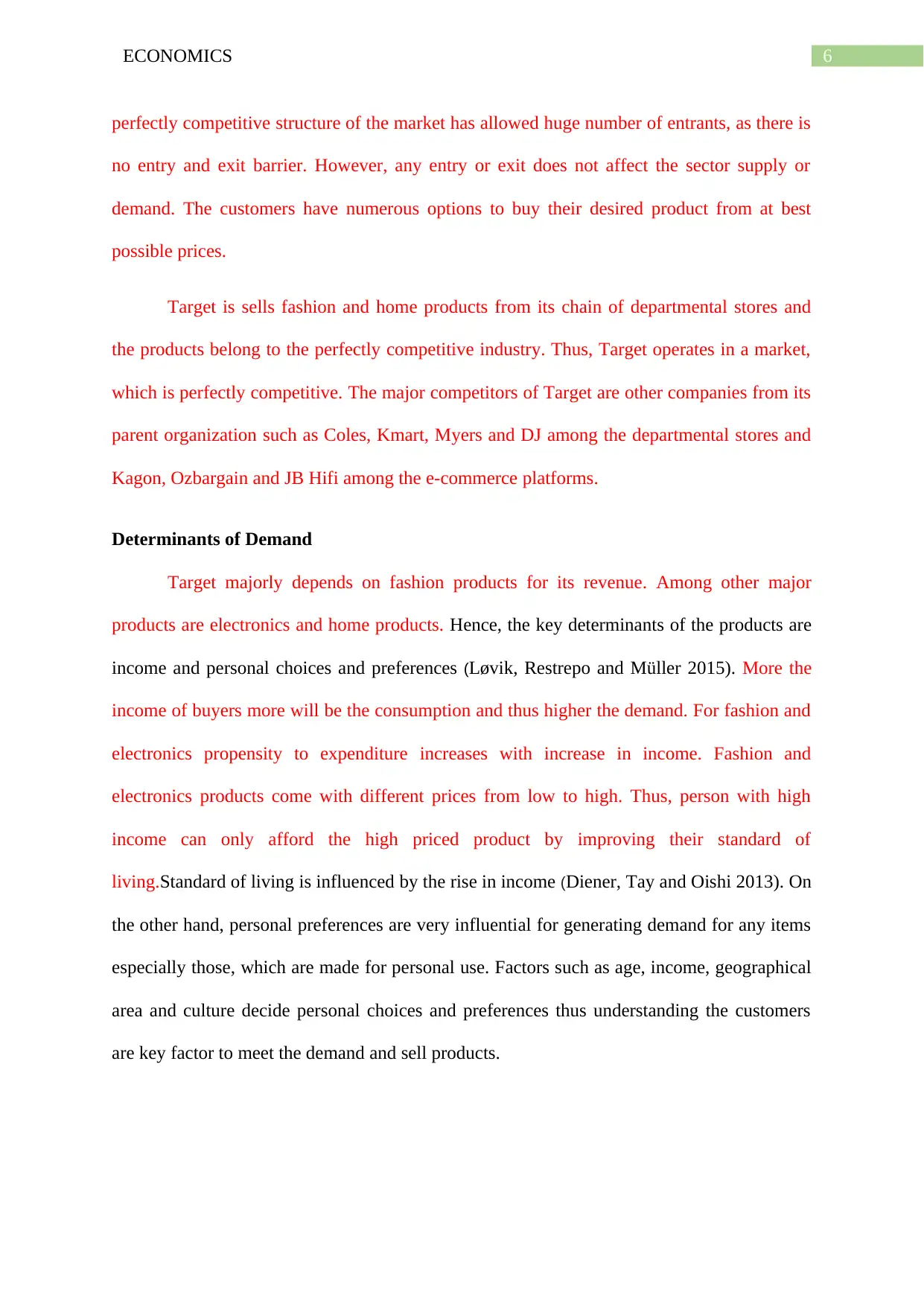
6ECONOMICS
perfectly competitive structure of the market has allowed huge number of entrants, as there is
no entry and exit barrier. However, any entry or exit does not affect the sector supply or
demand. The customers have numerous options to buy their desired product from at best
possible prices.
Target is sells fashion and home products from its chain of departmental stores and
the products belong to the perfectly competitive industry. Thus, Target operates in a market,
which is perfectly competitive. The major competitors of Target are other companies from its
parent organization such as Coles, Kmart, Myers and DJ among the departmental stores and
Kagon, Ozbargain and JB Hifi among the e-commerce platforms.
Determinants of Demand
Target majorly depends on fashion products for its revenue. Among other major
products are electronics and home products. Hence, the key determinants of the products are
income and personal choices and preferences (Løvik, Restrepo and Müller 2015). More the
income of buyers more will be the consumption and thus higher the demand. For fashion and
electronics propensity to expenditure increases with increase in income. Fashion and
electronics products come with different prices from low to high. Thus, person with high
income can only afford the high priced product by improving their standard of
living.Standard of living is influenced by the rise in income (Diener, Tay and Oishi 2013). On
the other hand, personal preferences are very influential for generating demand for any items
especially those, which are made for personal use. Factors such as age, income, geographical
area and culture decide personal choices and preferences thus understanding the customers
are key factor to meet the demand and sell products.
perfectly competitive structure of the market has allowed huge number of entrants, as there is
no entry and exit barrier. However, any entry or exit does not affect the sector supply or
demand. The customers have numerous options to buy their desired product from at best
possible prices.
Target is sells fashion and home products from its chain of departmental stores and
the products belong to the perfectly competitive industry. Thus, Target operates in a market,
which is perfectly competitive. The major competitors of Target are other companies from its
parent organization such as Coles, Kmart, Myers and DJ among the departmental stores and
Kagon, Ozbargain and JB Hifi among the e-commerce platforms.
Determinants of Demand
Target majorly depends on fashion products for its revenue. Among other major
products are electronics and home products. Hence, the key determinants of the products are
income and personal choices and preferences (Løvik, Restrepo and Müller 2015). More the
income of buyers more will be the consumption and thus higher the demand. For fashion and
electronics propensity to expenditure increases with increase in income. Fashion and
electronics products come with different prices from low to high. Thus, person with high
income can only afford the high priced product by improving their standard of
living.Standard of living is influenced by the rise in income (Diener, Tay and Oishi 2013). On
the other hand, personal preferences are very influential for generating demand for any items
especially those, which are made for personal use. Factors such as age, income, geographical
area and culture decide personal choices and preferences thus understanding the customers
are key factor to meet the demand and sell products.
Paraphrase This Document
Need a fresh take? Get an instant paraphrase of this document with our AI Paraphraser
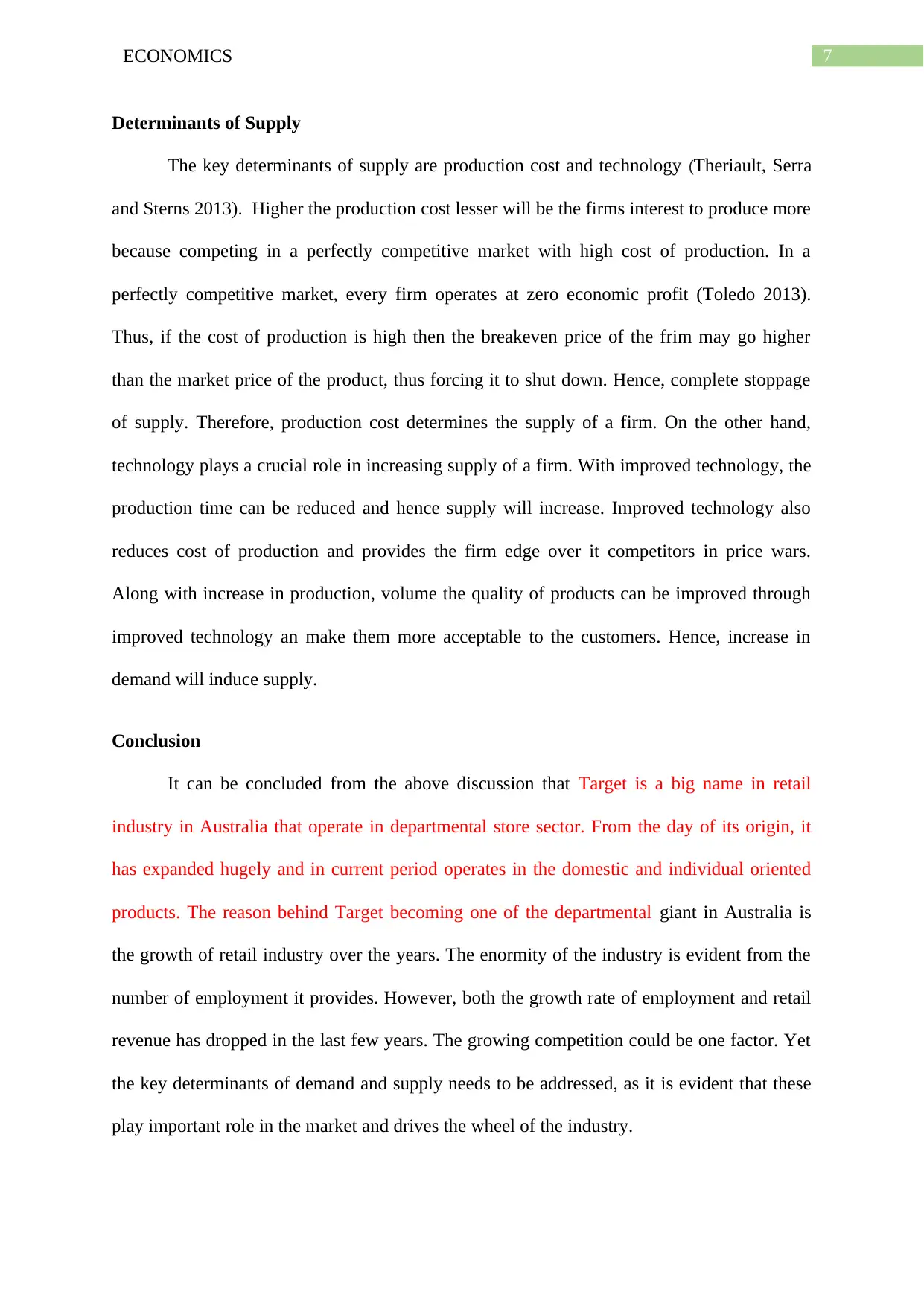
7ECONOMICS
Determinants of Supply
The key determinants of supply are production cost and technology (Theriault, Serra
and Sterns 2013). Higher the production cost lesser will be the firms interest to produce more
because competing in a perfectly competitive market with high cost of production. In a
perfectly competitive market, every firm operates at zero economic profit (Toledo 2013).
Thus, if the cost of production is high then the breakeven price of the frim may go higher
than the market price of the product, thus forcing it to shut down. Hence, complete stoppage
of supply. Therefore, production cost determines the supply of a firm. On the other hand,
technology plays a crucial role in increasing supply of a firm. With improved technology, the
production time can be reduced and hence supply will increase. Improved technology also
reduces cost of production and provides the firm edge over it competitors in price wars.
Along with increase in production, volume the quality of products can be improved through
improved technology an make them more acceptable to the customers. Hence, increase in
demand will induce supply.
Conclusion
It can be concluded from the above discussion that Target is a big name in retail
industry in Australia that operate in departmental store sector. From the day of its origin, it
has expanded hugely and in current period operates in the domestic and individual oriented
products. The reason behind Target becoming one of the departmental giant in Australia is
the growth of retail industry over the years. The enormity of the industry is evident from the
number of employment it provides. However, both the growth rate of employment and retail
revenue has dropped in the last few years. The growing competition could be one factor. Yet
the key determinants of demand and supply needs to be addressed, as it is evident that these
play important role in the market and drives the wheel of the industry.
Determinants of Supply
The key determinants of supply are production cost and technology (Theriault, Serra
and Sterns 2013). Higher the production cost lesser will be the firms interest to produce more
because competing in a perfectly competitive market with high cost of production. In a
perfectly competitive market, every firm operates at zero economic profit (Toledo 2013).
Thus, if the cost of production is high then the breakeven price of the frim may go higher
than the market price of the product, thus forcing it to shut down. Hence, complete stoppage
of supply. Therefore, production cost determines the supply of a firm. On the other hand,
technology plays a crucial role in increasing supply of a firm. With improved technology, the
production time can be reduced and hence supply will increase. Improved technology also
reduces cost of production and provides the firm edge over it competitors in price wars.
Along with increase in production, volume the quality of products can be improved through
improved technology an make them more acceptable to the customers. Hence, increase in
demand will induce supply.
Conclusion
It can be concluded from the above discussion that Target is a big name in retail
industry in Australia that operate in departmental store sector. From the day of its origin, it
has expanded hugely and in current period operates in the domestic and individual oriented
products. The reason behind Target becoming one of the departmental giant in Australia is
the growth of retail industry over the years. The enormity of the industry is evident from the
number of employment it provides. However, both the growth rate of employment and retail
revenue has dropped in the last few years. The growing competition could be one factor. Yet
the key determinants of demand and supply needs to be addressed, as it is evident that these
play important role in the market and drives the wheel of the industry.
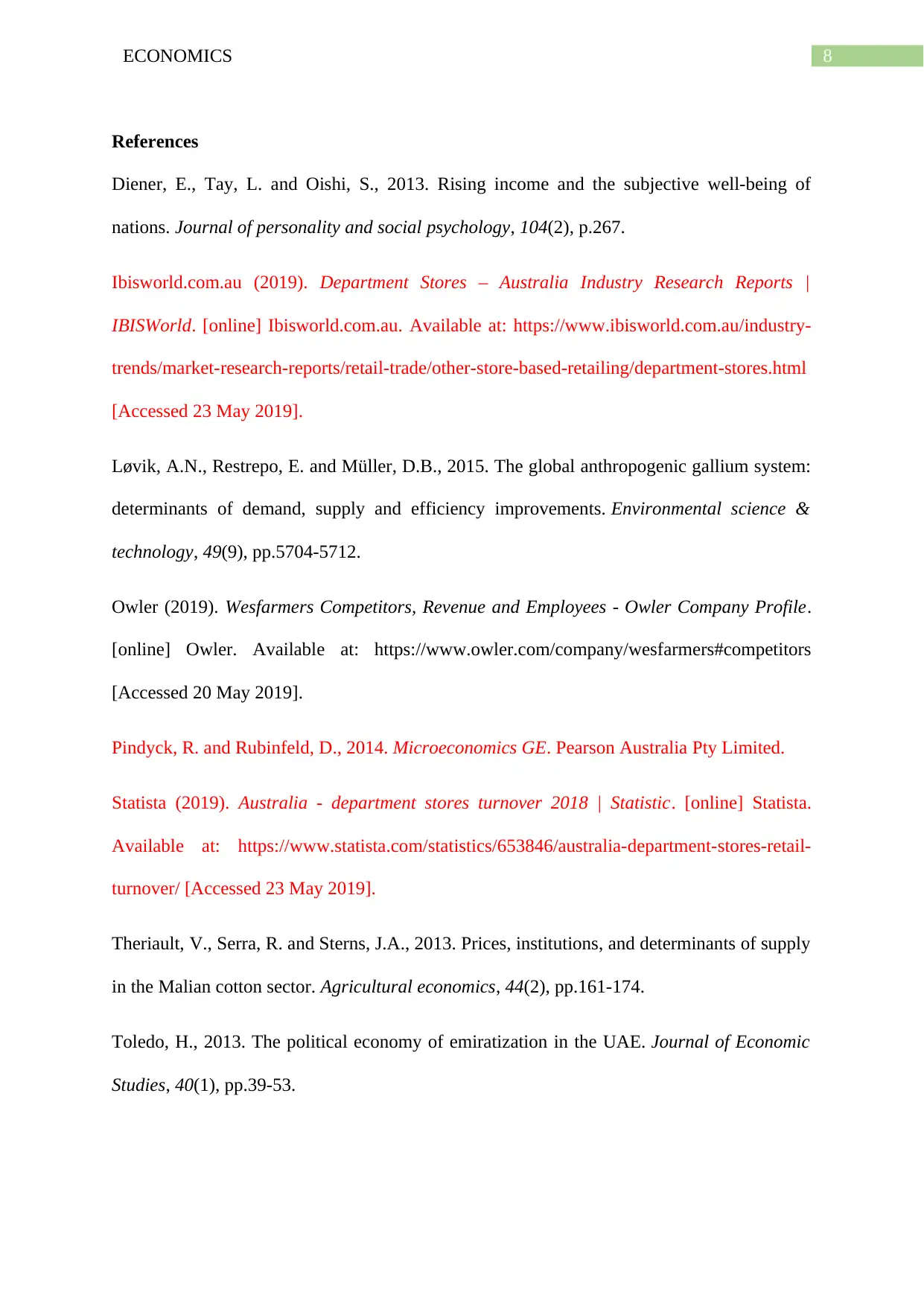
8ECONOMICS
References
Diener, E., Tay, L. and Oishi, S., 2013. Rising income and the subjective well-being of
nations. Journal of personality and social psychology, 104(2), p.267.
Ibisworld.com.au (2019). Department Stores – Australia Industry Research Reports |
IBISWorld. [online] Ibisworld.com.au. Available at: https://www.ibisworld.com.au/industry-
trends/market-research-reports/retail-trade/other-store-based-retailing/department-stores.html
[Accessed 23 May 2019].
Løvik, A.N., Restrepo, E. and Müller, D.B., 2015. The global anthropogenic gallium system:
determinants of demand, supply and efficiency improvements. Environmental science &
technology, 49(9), pp.5704-5712.
Owler (2019). Wesfarmers Competitors, Revenue and Employees - Owler Company Profile.
[online] Owler. Available at: https://www.owler.com/company/wesfarmers#competitors
[Accessed 20 May 2019].
Pindyck, R. and Rubinfeld, D., 2014. Microeconomics GE. Pearson Australia Pty Limited.
Statista (2019). Australia - department stores turnover 2018 | Statistic. [online] Statista.
Available at: https://www.statista.com/statistics/653846/australia-department-stores-retail-
turnover/ [Accessed 23 May 2019].
Theriault, V., Serra, R. and Sterns, J.A., 2013. Prices, institutions, and determinants of supply
in the Malian cotton sector. Agricultural economics, 44(2), pp.161-174.
Toledo, H., 2013. The political economy of emiratization in the UAE. Journal of Economic
Studies, 40(1), pp.39-53.
References
Diener, E., Tay, L. and Oishi, S., 2013. Rising income and the subjective well-being of
nations. Journal of personality and social psychology, 104(2), p.267.
Ibisworld.com.au (2019). Department Stores – Australia Industry Research Reports |
IBISWorld. [online] Ibisworld.com.au. Available at: https://www.ibisworld.com.au/industry-
trends/market-research-reports/retail-trade/other-store-based-retailing/department-stores.html
[Accessed 23 May 2019].
Løvik, A.N., Restrepo, E. and Müller, D.B., 2015. The global anthropogenic gallium system:
determinants of demand, supply and efficiency improvements. Environmental science &
technology, 49(9), pp.5704-5712.
Owler (2019). Wesfarmers Competitors, Revenue and Employees - Owler Company Profile.
[online] Owler. Available at: https://www.owler.com/company/wesfarmers#competitors
[Accessed 20 May 2019].
Pindyck, R. and Rubinfeld, D., 2014. Microeconomics GE. Pearson Australia Pty Limited.
Statista (2019). Australia - department stores turnover 2018 | Statistic. [online] Statista.
Available at: https://www.statista.com/statistics/653846/australia-department-stores-retail-
turnover/ [Accessed 23 May 2019].
Theriault, V., Serra, R. and Sterns, J.A., 2013. Prices, institutions, and determinants of supply
in the Malian cotton sector. Agricultural economics, 44(2), pp.161-174.
Toledo, H., 2013. The political economy of emiratization in the UAE. Journal of Economic
Studies, 40(1), pp.39-53.
⊘ This is a preview!⊘
Do you want full access?
Subscribe today to unlock all pages.

Trusted by 1+ million students worldwide
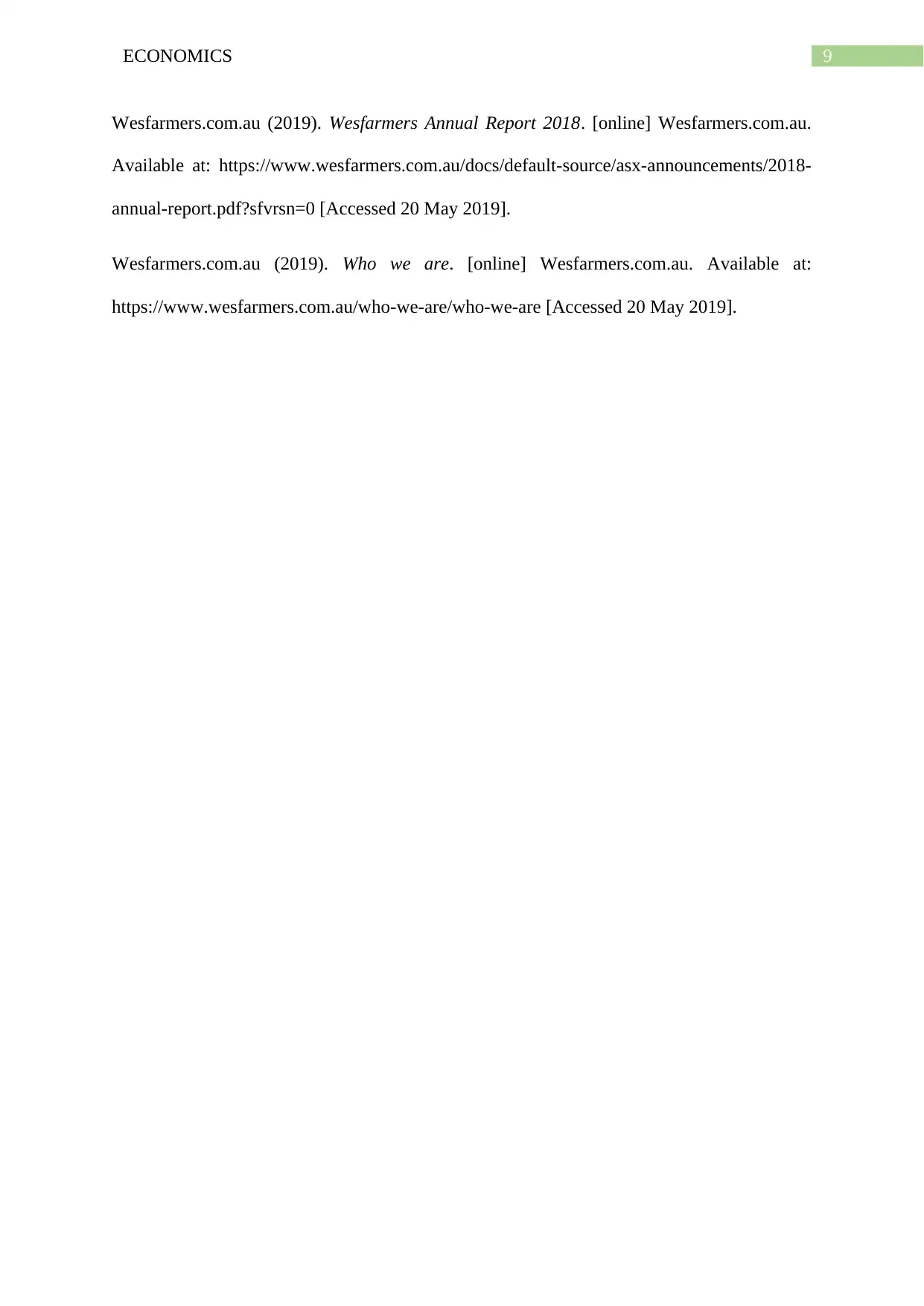
9ECONOMICS
Wesfarmers.com.au (2019). Wesfarmers Annual Report 2018. [online] Wesfarmers.com.au.
Available at: https://www.wesfarmers.com.au/docs/default-source/asx-announcements/2018-
annual-report.pdf?sfvrsn=0 [Accessed 20 May 2019].
Wesfarmers.com.au (2019). Who we are. [online] Wesfarmers.com.au. Available at:
https://www.wesfarmers.com.au/who-we-are/who-we-are [Accessed 20 May 2019].
Wesfarmers.com.au (2019). Wesfarmers Annual Report 2018. [online] Wesfarmers.com.au.
Available at: https://www.wesfarmers.com.au/docs/default-source/asx-announcements/2018-
annual-report.pdf?sfvrsn=0 [Accessed 20 May 2019].
Wesfarmers.com.au (2019). Who we are. [online] Wesfarmers.com.au. Available at:
https://www.wesfarmers.com.au/who-we-are/who-we-are [Accessed 20 May 2019].
1 out of 10
Related Documents
Your All-in-One AI-Powered Toolkit for Academic Success.
+13062052269
info@desklib.com
Available 24*7 on WhatsApp / Email
![[object Object]](/_next/static/media/star-bottom.7253800d.svg)
Unlock your academic potential
Copyright © 2020–2025 A2Z Services. All Rights Reserved. Developed and managed by ZUCOL.




